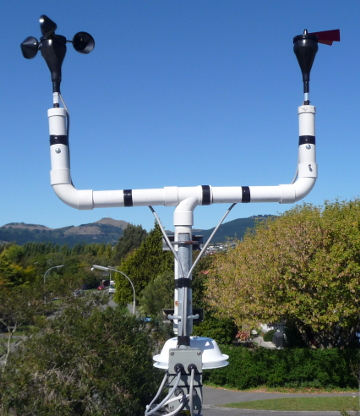After building 3 wind vanes over 10 years, I decided to buy one after the 3rd wind vane seized on the 1st of March 2009. I had used bearings from old printers and disk drives but exposure to dampness over time, not direct rain had been a problem.
I have replaced by home built vane with a Maximum Instruments wind vane what has the same bearing as the Maximum anemometer I've used since December 2000.
Maximum kindly provided the technical information required for interfacing this vane to my instrument interface.
 This vane provides 16 compass points with 8 magnetic reed switches where 1 or 2 switches can be on to represent wind direction. Only 5 wires are needed to run from the roof to the instrument interface as as the case with the previous vane. One wire is used for power. I installed it over the weekend of the 28th and 29th of March 2009. The job took longer then expected but there was other maintenance to do on the roof instruments and it was a sunny and dry weekend to get the work done. Since there are 16 compass points, I have aligned the vane as closely as I can to true north. Therefore, the directions displayed now will be slightly different to those of the old vane.
This vane provides 16 compass points with 8 magnetic reed switches where 1 or 2 switches can be on to represent wind direction. Only 5 wires are needed to run from the roof to the instrument interface as as the case with the previous vane. One wire is used for power. I installed it over the weekend of the 28th and 29th of March 2009. The job took longer then expected but there was other maintenance to do on the roof instruments and it was a sunny and dry weekend to get the work done. Since there are 16 compass points, I have aligned the vane as closely as I can to true north. Therefore, the directions displayed now will be slightly different to those of the old vane.
After building the additional circuitry and testing the outputs I found that the vane is not that accurate in its 22.5 degree segments. Overall, the sensitivity and potential longevity of the vane outweigh these limitations and I must remember that this vane is built for Maximum's weather stations that indicate the wind direction as the owner is looking at it rather then record the data as I do. This vane is also much more sensitive then the old vane so I can report the wind direction at lower speeds. I should be reporting a direction if the anemometer is turning. Since they both use the same bearing, if the wind is strong enough to turn the anemometer, it should be able to give a valid wind direction.
I had some teething problems when I initially got it working. I was reporting wind speeds of over  250km/h and I suspected noise on the cable from the anemometer. I eventually traced the problem to my lack of filtering of the values expected from the wind vane. The vane is read in 2 parts, the binary code is read at +5V and then the supply to the vane is grounded and the vane read again 33mS later. In the time between the 2 readings, the vane can change direction and the second reading is from a different direction. This created a value greater then I was expecting, causing the wind vane value being passed to the weather station PC being much larger then it should be. I put a value limit in the Picaxe firmware and it has been resolved.
250km/h and I suspected noise on the cable from the anemometer. I eventually traced the problem to my lack of filtering of the values expected from the wind vane. The vane is read in 2 parts, the binary code is read at +5V and then the supply to the vane is grounded and the vane read again 33mS later. In the time between the 2 readings, the vane can change direction and the second reading is from a different direction. This created a value greater then I was expecting, causing the wind vane value being passed to the weather station PC being much larger then it should be. I put a value limit in the Picaxe firmware and it has been resolved.